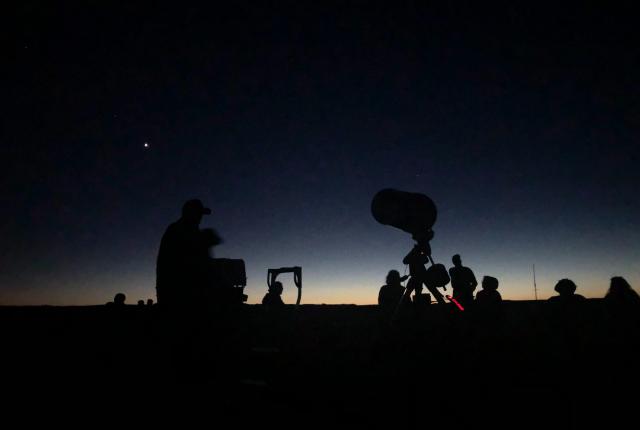STARGAZING MAY NOT BE the first thing that comes to mind when visiting Fort Union National Monument. But the largest 19th-century military fort in the region sits on a strategic swath of open prairie along the Santa Fe Trail, which makes the Mora County spot ideal for viewing the natural night skies.
I’ve come for the Night Wonders program in late June for a little history and to experience some of the darkest skies in the country. Designated a Dark Sky Park in 2019, Fort Union measures 21.6 out of 22 on the sky quality meter, making it a Class 2 dark sky. “That’s a spectacular sky,” says ranger Michael Tudor, as he adjusts the 11-inch telescope.
About 20 of us have turned out for the free monthly event. We take turns looking through the viewfinder at Venus, Mars, and then the moon. Through the telescope, the moon’s craters look like pitted metal. But the bright near-half-moon washes out the Milky Way as it rises over the visitor center and dims some part of the overall experience.
“A long time ago, the night sky was the source of folklore and mythology,” Tudor explains. “But beyond having a dark sky for its sense of wonderment and awe, it’s also very important for wildlife.” Tudor and a fellow ranger explain how the yucca plant relies exclusively on the nocturnal yucca moth for its pollination, and how the dung beetle, which lives on the national monument grounds, uses the Milky Way to chart its way.
“The national parks were created to help protect our natural resources,” Tudor says. “Even though a lot of people don’t think of them that way, that’s what we’re doing here with our dark skies.”
The good news, as we explore in this month’s “Heavens on Earth” feature story, is that New Mexico does value and protect our night skies. That’s demonstrated by our nine Dark Sky Places, a host of astronomy clubs, and a legacy of Indigenous star stories.
As Tudor points the telescope toward the Ring Nebula for a look into deep space, I gaze at the stars in all directions. The constellation Scorpius stands out against the Milky Way, and the tapestry above appears three-dimensional, extending toward me like a string of lights. While I am here, reaching for the stars, they seem to be reaching out to me. It’s as close as I’ve ever felt to the heavens, and all the more connected to the wonders of the universe.
Read more: Here's where you'll find New Mexico's nine dark sky places.



